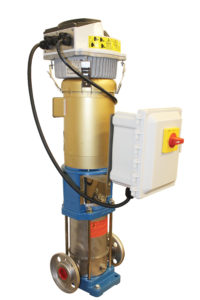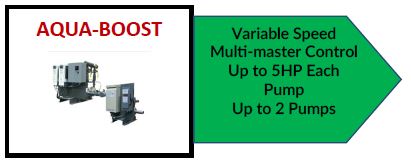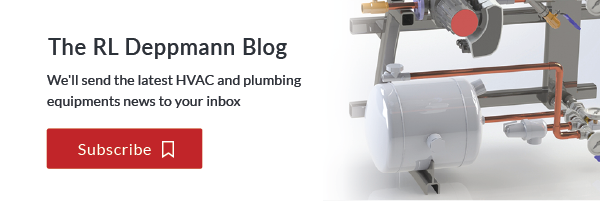 Domestic water pressure booster pumping systems come in a variety of types. Bell & Gossett manufactures a variety of models to fit multiple needs. Which one should you choose to specify for a project? This is the subject of the R. L Deppmann Monday Morning Minutes for this week.
Domestic water pressure booster pumping systems come in a variety of types. Bell & Gossett manufactures a variety of models to fit multiple needs. Which one should you choose to specify for a project? This is the subject of the R. L Deppmann Monday Morning Minutes for this week.
Over the last few articles, I have covered the suction and discharge pressures required and the number of pumps required for a pressure booster system. Let’s look at the key features and benefits you may choose for your clients.
Variable Speed is a “Ticket to the Dance”
The ASHRAE 90.1 Energy Standard recommends variable speed pumping in pressure booster applications. Changing the speed to maintain a pressure set point at the top of the system is required by this standard and many codes. This will save energy and money. It will save even more money and energy when the municipal suction pressure is varying.
Multi-Master Control – Redundancy
Obviously, a single pump pressure booster will become the least expensive system to install. The minute we use two pumps there is the complexity of staging the parallel pumps. If the system employs two pumps and one pump stops working, there is a natural expectation that the remaining pump will operate while we call for service. The expectation may be natural but the reality is not always so obvious.
Somewhere in the system is a controller. It may be a standalone programmable logic controller (PLC) or it may be part of the variable frequency drive (VFD). If the VFD arrangement is set up as a lead/follow, what happens if the lead drive or pump fails? The ability of either drive to become the leader is important.
Good pressure booster systems provide this control redundancy. Better systems do it automatically.
In addition, you may want to specify whether this happens automatically or if there is a human interface required. Some systems require a quick shutdown and/or a manual switchover. Others can do this automatically. The term “multi-master” may have different meanings for different manufacturers, so I suggest the following: Upon failure of one or more drives or pumps, the system shall automatically transfer control functions to one of the operating pump/drive combinations. The system shall alert the owner of the failure through audio/visual alarm and, if indicated elsewhere, through the building automation system.
Better Systems: Independent Pump/Drive Circuit Breakers or Disconnects
Many good pressure booster systems have a disconnect means to shut down the entire system for service. The better systems provide a means of isolating the individual drive and pump so service may be performed without shutting the system down.
In addition to the electrical isolation of individual drives, the better systems should have shutoff valves to service the pump. The Bell & Gossett e-HV pressure booster is one example of a better system.
Best Systems: Control Options, Fine Tuning Adjustments and Trending Analysis
Detroit, the Motor City, is really hopping these days. Renovation of multiple older buildings, new high rise buildings, clubs, entertainment, sports facilities, infrastructure changes, and significant increases in residential offerings provide an atmosphere that taxes the municipal water systems. Bell & Gossett just featured Detroit in one of their advertising layouts.
Why mention this? The construction and increased population create faster and wide swings in city water pressure. Some of the piping was designed for smaller loads and develops more pressure drop swings as the flow changes. This type of change and diversity of use requires a pressure booster system where the PID loop, the response of minimum and maximum pressure settings, proof timers, and staging controls have fine tuning capabilities. This is where the best systems shine. The Bell & Gossett e-MT pressure booster is a great example of the BEST.
Trending of pressures, staging, and faults is another benefit of the “best” systems. The owner’s personnel can identify quickly what issues are reoccurring and anticipate a problem before it happens.
Premium Systems: Emergency Generators and Jockey Pumps
There is another level of performance in pressure boosters. The premium models can actually limit the KW when using auxiliary power sources. Generators are expensive and keeping the KW to a minimum during those emergency times leaves more power for critical processes in the building.
If your system is larger, the use of a jockey pump system may be your best choice. Imagine a system where there are two 10 HP pumps that alternate for very low flow rates. Imagine a system when the demand increases, a group of three 40 HP pumps stage on while the 10 HP jockey pumps are decommissioned. Imagine the energy savings of a system like this. You don’t need to imagine it, just look to the Bell & Gossett XLS pressure booster.
If you need help determining which system to choose, just contact R. L. Deppmann or your local B&G representative.
Next week, we conclude this series with a look at ASHRAE 90.1-2013 pressure booster requirements and how to incorporate them in your design.
Catch up on recent Pressure Booster Pumping System posts:
- Point of Use Pressure Boosting
- Plumbing System Design; Pressure Booster Domestic Water Recirculation Resource
- What is a Building Pressure Booster?
- Domestic Water “Pressure Booster Pumping System” – Discharge Pressure
- Domestic Water “Pressure Booster Pumping System” – Suction Pressure
- Domestic Water “Pressure Booster Pumping System” – Control Head & Curves
- Domestic Water “Pressure Booster Pumping System” – Number of Pumps






